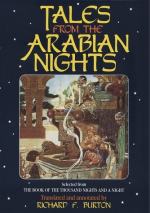de V. 1777. 12mo.
12. Mahulem, histoire orientale. 12mo, 1776.
13. Mille et une heure, contes Peruviens. 4 vols. 12mo,
1733.
14. Histoire de Khedy, Hermite de Mont Ararat. Conte
orientale, traduit de l’Anglais, 12mo, 1777.
15. Zambeddin, histoire orientale. 12mo, 1768.
16. Zelmoille et Zulmis et Turlableu. Par M. l’Abbe de
Voisem, 12mo, 1747.
17. Roman Oriental, Paris, 1753.
The remaining imitations, &c., known to me I shall place roughly in chronological order, premising that I fear the list must be very incomplete, and that I have met with very few except in English and French.
A.—French
1. Zadig, ou la Destinee, par Voltaire[FN#473] probably partakes of classes 2 and 6; said to be partly based on Gueulette’s “Soirees Bretonnes,” published in 1712. The latter is included in Cabinet des Fees, Vol. 32.
2. Vathek, an Arabian Tale, by William Beckford. I include this book here because it was written and first published in French. Its popularity was once very great, and it contains some effective passages, though it belongs to Class 2, and is rather a parody than an imitation of Oriental fiction. The Caliph Vathek, after committing many crimes at the instance of his mother, the witch Carathis, in order to propitiate Eblis, finally starts on an expedition to Istakar. On the way, he seduces Nouronihar, the beautiful daughter of the Emir Fakreddin, and carries her with him to the Palace of Eblis, where they am condemned to wander eternally, with their hearts surrounded with flames.
This idea (which is certainly not Oriental, so far as I know) took the fancy of Byron, who was a great admirer of Vathek, and he has mixed it with genuine Oriental features in a powerful passage in the Giaour, beginning:
“But
thou, false infidel! shalt writhe
Beneath
avenging Monkir’s scythe;
And
from its torment ’scape alone
To
wander round lost Eblis’ throne;
And
fire unquenched, unquenchable,
Around,
within thy heart shall dwell;
Nor
ear can hear, nor tongue can tell
The
tortures of that inward hell!” &c.
How errors relative to Eastern matters are perpetuated is illustrated by the fact that I have seen these lines quoted in some modern philosophical work as descriptive of the hell in which the Mohammedans believe!
Southey, in Thalaba, b. 1., speaks of the Sarsar, “the Icy Wind of Death,” an expression which he probably borrowed from Vathek.
3. The Count of Hamilton’s Fairy Tales.
Written shortly after
the first publication
of Galland’s work. There is an English
Translation among Bohn’s
Extra Volumes.
4. Les Mille et un Fadaises, par Cazotte.
Class 1. I have not
seen them.




